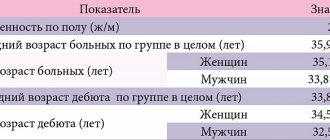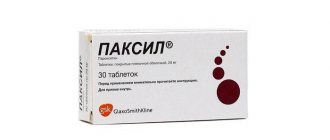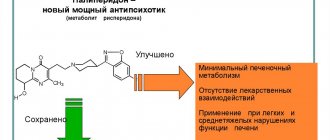Pharmacodynamics and pharmacokinetics
The substance blocks the work of central n1-histamine and m-cholinergic receptors . The drug exhibits a sedative effect and has moderate anxiolytic activity . Hydroxyzine is a fairly mild tranquilizer that also has an antiemetic effect.
The product improves cognitive abilities, attention and accelerates memory processes. As a rule, Hydroxyzine preparations do not cause dependence, either mental or physiological. Even after prolonged use, withdrawal syndrome does not develop.
This substance also has antispasmodic, antihistamine and anticholinergic effects, relieves pain and moderately inhibits the production of gastric acids. The medicine is often prescribed to reduce itching in eczema, urticaria, dermatitis , etc.
Depending on the dosage form, the effect of taking the substance will be observed within 10-40 minutes. The antihistamine effect occurs 60 minutes after oral administration.
After taking the tablets, the substance is quickly absorbed by the body. Reaches its maximum concentration in the blood within 2 hours. The drug overcomes the blood-brain and placental barriers. The half-life is up to 7 hours in children, about 20 in adults.
In persons suffering from liver failure, due to the fact that the drug is metabolized in the liver (metabolite - ceterizine ), the antihistamine effect can last a long time (more than 90 hours), and the half-life will increase to 37.
Pharmacokinetic parameters in elderly people are slightly altered, the half-life lasts up to 29 hours. Hydroxyzine is excreted through the kidneys in the form of metabolites, less than one percent remains unchanged.
During clinical trials and animal studies, no carcinogenic or mutagenic effects of the drug on the body were revealed.
Hydroxyzine Canon, 25 pcs., 25 mg, film-coated tablets
Pharmacotherapeutic group: anxiolytic agent (tranquilizer)
ATX code: [N05BB01]
Pharmacological properties
Pharmacodynamics Hydroxyzine is a first-generation H1-histamine receptor blocker, a derivative of phenothiazine with antimuscarinic and sedative properties and diphenylmethane, which helps inhibit the activity of certain subcortical zones. It has H1-histamine blocking, bronchodilating and antiemetic effects, and has a moderate inhibitory effect on gastric secretion. Hydroxyzine significantly reduces itching in patients with urticaria, eczema and dermatitis. Hydroxyzine has a positive effect on cognitive abilities, improves attention and memory. Hydroxyzine does not cause addiction or mental dependence; with prolonged use, no withdrawal syndrome has been observed. Hydroxyzine is capable of depressing the central nervous system, and also has anticholinergic, antihistamine, antispasmodic, local anesthetic, sympatholetic effects, and has muscle relaxant activity. In case of liver failure, the H1-histamine blocking effect can be prolonged up to 96 hours after a single dose. Has moderate anxiolytic activity. Polysomnography in patients with insomnia and anxiety demonstrates an increase in sleep duration and a decrease in the frequency of night awakenings after single or repeated administration of hydroxyzine at a dose of 50 mg. A decrease in muscle tension in patients with anxiety was noted when taking the drug at a dose of 50 mg 3 times a day. The H1-histamine blocking effect occurs approximately 1 hour after taking the tablets orally. The sedative effect appears after 30-45 minutes.
Pharmacokinetics.
Absorption: Absorption is high. The time to reach maximum concentration (TCmax) after oral administration is 2 hours. After taking an average dose of 50 mg, the Tmax in adults is 70 mg/ml. Distribution: The distribution coefficient is 7-16 l/kg in adults. Hydroxyzine penetrates the blood-brain barrier and the placenta, concentrating more in fetal than maternal tissues. After oral administration, hydroxyzine penetrates well into the skin, with hydroxyzine concentrations in the skin far exceeding serum concentrations after both single and multiple doses. Plasma concentration of hydroxyzine does not necessarily reflect its tissue binding or distribution at skin receptors. It has an effect on skin inflammation depending on serum concentration. Metabolism: Hydroxyzine is metabolized in the liver. Cetirizine - the main metabolite (45%) is a blocker of H1-histamine receptors. Metabolites are found in breast milk. Elimination: Half-life (T1/2) in adults is 14 hours (range: 7-20 hours). The total clearance of hydroxyzine is 13 ml/min/kg. About 0.8% of hydroxyzine is excreted unchanged through the kidneys. The main metabolite cetirizine is excreted mainly in the urine, also unchanged (25% of the dose of hydroxyzine). Pharmacokinetics in special groups of patients. In elderly patients In elderly patients T1/2 was 29 hours. The volume of distribution is 22.5 l/kg. It is recommended to reduce the daily dose of hydroxyzine when prescribed to elderly patients. Children under 1 year In children, the total clearance is 2.5 times higher than in adults. The dose must be adjusted. The half-life is 4 hours. Children from 1 year to 14 years The half-life is 11 hours. In patients with liver failure In patients with liver dysfunction secondary to primary biliary cirrhosis, the total clearance was approximately 66% of the value recorded in healthy volunteers. In patients with liver diseases, T1/2 increased to 37 hours, the concentration of metabolites in the blood serum was higher than in young patients with normal liver function. For patients with liver failure, a reduction in the daily dose or frequency of administration is recommended. In patients with renal failure The pharmacokinetics of hydroxyzine was studied in 8 patients with severe renal failure (creatinine clearance 24+7 ml/min). The duration of exposure to hydroxyzine did not change significantly, while the duration of exposure to cetirizine was increased. To avoid any significant accumulation of cetirizine metabolite after repeated use of hydroxyzine in patients with impaired renal function, the daily dose of hydroxyzine should be reduced.
Indications for use
Hydroxyzine hydrochloride is prescribed:
- to eliminate anxiety and increased excitability of the nervous system;
- alcoholics during abstinence;
- for psychoneurotic disorders ;
- as part of complex treatment after operations and some injuries;
- for premedication ;
- with internal tension, adaptation disorders, generalized anxiety , somatic diseases;
- to relieve symptoms of atopic dermatitis, itchy dermatosis, urticaria, eczema ;
- as an antiemetic according to indications.
Contraindications
The medicine is not recommended for use:
- patients with glaucoma ;
- with prostatic hypertrophy ;
- if the patient has increased seizure activity;
- with myasthenia gravis ;
- patients with renal and liver failure;
- for dementia ;
- pregnant women;
- with porphyria ;
- during lactation;
- if you are allergic to the active substance, including if hypersensitivity reactions to other piperazine derivatives, cetirizine, ethylenediamine or aminophylline ;
- during labor.
Side effects
In the first few days of using Hydroxyzine, drowsiness, general weakness, dizziness and headache may occur.
The following may also appear:
- tachycardia , allergic reactions, nausea;
- constipation and urinary retention;
- dry mucous membranes, increased sweating;
- disturbances of vision and accommodation of the eye;
- low blood pressure , fever , increased levels of liver enzymes;
- bronchospasm.
Very rarely, patients undergoing treatment with Hydroxyzine experienced convulsions, tremors and disorientation , paradoxical agitation and increased motor activity, ataxia .
As a rule, most reactions are transient or disappear after reducing the daily dosage.
Hydroxyzine, instructions for use (Method and dosage)
The drug is prescribed orally or intramuscularly , depending on the form of release, disease and age.
For the symptomatic treatment of anxiety, adults are recommended to take 25 to 100 mg of the substance per day. As a rule, 12.5 mg is used in the morning and at lunch and 25 before bed.
Children before surgery are prescribed 1 mg per kg of weight 60 minutes before the procedure. Administration of one dose the night before is also indicated.
Premedication for adults is carried out in dosages of 50 to 200 mg orally or 1.5-2.5 mg per kg of patient weight intramuscularly , one hour before surgery.
To eliminate itching, use from 25 to 100 mg of the drug, 3-4 times a day.
For the treatment of itching in children from one to 6 years of age, 1-2.5 mg per kg of child weight per day is prescribed, in several doses.
Children over 6 years of age - from 1 to 2 mg per kg of body weight per day, the dosage regimen is the same.
The maximum daily dosage is 300 mg. The maximum single dosage is 200 mg.
Elderly persons are recommended to begin treatment with doses reduced by half.
In case of hepatic and renal failure, dose adjustment is required.
If you need to quickly achieve a therapeutic effect, Hydroxyzine solution is administered intramuscularly , deeply, 50-100 mg at a time. It is recommended to administer the drug every 4-6 hours.
Acetylcysteine Canon (100mg, 200mg, 600mg)
Pharmacodynamics
Acetylcysteine is a mucolytic expectorant used to thin mucus in diseases of the respiratory system. Acetylcysteine is a derivative of the natural amino acid cysteine (N-acetyl-L-cysteine). It has a pronounced mucolytic effect and belongs to the class of direct mucolytics.
The action of acetylcysteine is associated with the ability of the free sulfhydryl group to cleave intra- and intermolecular disulfide bonds of sputum glycoprotein aggregates, which leads to depolarization of mucoproteins, having a strong thinning effect and reducing the viscosity of mucus. Acetylcysteine exhibits mucolytic activity against any type of sputum - mucous, mucopurulent, purulent. Acetylcysteine increases the secretion of less viscous sialomucins by goblet cells and reduces the adhesion of bacteria to the epithelial cells of the bronchial mucosa. Stimulates mucous cells of the bronchi, the secretion of which is lysed by fibrin.
Acetylcysteine thins sputum, increases its volume, facilitates sputum separation and significantly softens cough.
In addition to the direct mucolytic effect, acetylcysteine has powerful antioxidant pneumoprotective properties that provide effective protection of the respiratory system from the toxic effects of negative factors: inflammatory metabolites, environmental factors, and tobacco smoke.
Acetylcysteine has a direct antioxidant effect because it includes a free thiol group (-SH), which can interact directly with and neutralize electrophilic oxidative toxins.
Acetylcysteine protects alpha1-antitrypsin (an enzyme that inhibits elastase) from loss of activity that may occur as a result of exposure to HOCL, a powerful oxidative substance produced by the myeloperoxidase enzyme of active phagocytes.
Easily penetrating into the cell, acetylcysteine is deacetylated, releasing L-cysteine, an amino acid necessary for the synthesis of glutathione, which is the most important factor in intracellular protection against exogenous and endogenous oxidative toxins and various cytotoxic substances. This feature of acetylcysteine makes it possible to effectively use the latter in acute poisoning with paracetamol and other toxic substances (aldehydes, phenols, etc.).
The mucolytic properties of acetylcysteine begin to appear within 1 to 2 days from the start of therapy. When taken prophylactically, acetylcysteine reduces the frequency and severity of exacerbations of chronic bronchitis and cystic fibrosis.
Pharmacokinetics
After oral administration, acetylcysteine is quickly and almost completely absorbed from the digestive tract. In the liver it is metabolized to cysteine (a pharmacologically active metabolite) and diacetylcystine, cystine and then to mixed disulfides. The bioavailability of acetylcysteine after oral administration is about 10% due to the pronounced “first pass” effect through the liver. The maximum concentration of the drug (Cmax) after oral administration is reached within 1-3 hours. In the body, acetylcysteine and its metabolites are determined in various forms: partly as a free substance, partly in connection with blood plasma proteins, partly as incorporated amino acids. It is excreted almost completely in the form of inactive metabolites (inorganic sulfates, diacetylcystine) by the kidneys. Only a small amount of acetylcysteine is excreted unchanged through the intestines. The half-life (T½) from blood plasma is approximately 1 hour and depends on the rate of biotransformation in the liver. In case of liver failure, it can increase to 8 hours. Acetylcysteine can cross the placental barrier and accumulate in the amniotic fluid.
Overdose
If therapeutic doses are exceeded, the following may develop: tremor , hallucinations , convulsions , hypersedation , low blood pressure, nausea, disorientation and confusion .
If an overdose of tablets occurs, it is recommended to induce vomiting and rinse the stomach. Monitoring of the patient's vital functions, administration of norepinephrine , caffeine sodium benzoate and blood substitutes are also indicated, measures should be taken to maintain the normal functioning of the body. The drug does not have a specific antidote ; hemodialysis is not performed.
Interaction
Hydroxyzine reduces the effectiveness of adrenaline .
The drug enhances the sedative effect of taking narcotic analgesics, tranquilizers, alcohol, barbiturates, hypnotics , and other drugs that depress the central nervous system.
It is not recommended to combine this substance with anticholinergics or MAO inhibitors .
The drug reduces the anticonvulsant effect of taking phenytoin .
The medicine is not recommended to be combined with cholinesterase .
The drug inhibits P450 2D6 and in high dosages may cause interaction with CYP2D6 .
When used in combination with liver enzyme inhibitors, the plasma concentration of the drug may increase.
Drug interactions
Hydroxyzine interferes with the action of cholinesterase inhibitors and betahistine, the anticonvulsant activity of phenytoin and the pressor effect of epinephrine.
When using cimetidine in a daily dose of 1200 mg (600 mg 2 times a day), the concentration of hydroxyzine in the serum increases by 36%, and the maximum concentration of the cetirizine metabolite decreases by 20%.
Hydroxyzine may mask symptoms of ototoxicity caused by drugs with ototoxic effects (eg, gentamicin).
The potentiating effect of hydroxyzine should be taken into account during concomitant use of CNS depressants (for example, tranquilizers, barbiturates, hypnotics, analgesics, ethanol). In these cases, the doctor must select the dose of each drug individually.
Combined use with drugs that have the potential to cause arrhythmia may lead to an increased risk of QT prolongation and torsade de pointes (TdP).
The combined use of Hydroxyzine Canon with monoamine oxidase inhibitors and anticholinergic blockers should be avoided.
As an inhibitor of the CYP2D6 isoenzyme, hydroxyzine in high doses can interact with CYP2D6 substrates.
Hydroxyzine is metabolized in the liver, so it is possible to increase its concentration in the blood plasma with simultaneous use of inhibitors of microsomal liver enzymes.
The concentration of hydroxyzine in the blood plasma may increase in case of concomitant use of drugs that potentially inhibit the CYP3A4/5 isoenzyme, such as delavirdine, ketoconazole, voriconazole, clarithromycin, itraconazole, posaconazole, stiripentol, telithromycin, some HIV protease inhibitors, including indinavir, atazanavir, nelfinavir, saquinarine, ritonavir, saquinarine/ritonavir, lopinavir/ritonavir, tipranavir/ritonavir. However, inhibition of one metabolic pathway may be partially compensated by the activity of another.
Reviews of Hydroxyzine
Some reviews about the medicine:
- “... Before using this medicine, I tried everything. Grandaxin , Coaxil, nothing helped me. Only with Hydroxyzine did I feel better, calmer and more confident”;
- “... I was prescribed medicine for panic attacks and insomnia. After taking it I slept very well. When you stop drinking, of course, it’s hard to stop drinking at first, but overall I liked the effect of the medicine.”
- “A neurologist recently prescribed this drug to my daughter; she is too mobile and has decreased concentration. During treatment, my daughter remained active and cheerful, but became more confident, focused and attentive, and her mood stopped changing sharply. I didn’t notice any adverse reactions.”
Reviews on the choice of medications
Reviews about Hydroxyzine are positive. The drug is the safest in its pharmaceutical group:
- Movchan D.I., psychiatrist: “Hydroxyzine is well tolerated by patients and is used to relieve even severe psychopathic conditions. Treatment of alcoholic asthenia is more effective with the use of this medication. Of the non-structural analogues, I would like to mention Gidazepam and Afobazol. These drugs are not inferior in effectiveness to Hydroxyzine and also have low toxicity to the body.”
- Sergei, 38 years old: “Psychoses and neuroses began to develop in me after severe stress and mental trauma. The use of Hydroxyzine in treatment helped me restore my normal state of mind and significantly strengthen my frayed nerves. I tried to change it with Afobazole to avoid addiction, but it didn’t help much, so I went back to Hydroxyzine.”
Hydroxyzine is the most popular anxiolytic drug, which is often prescribed as a tranquilizer. This medication has low toxicity and is not addictive during long-term therapy.



